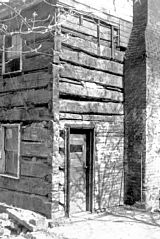
Historical Society wants to rebuild oldest structure in South Fayette
That hardly sounds new in 2008, but Mr. Cardillo was a boy in the 1930s, so the house was only about 60 years old. It was connected to the old house — a 1780s structure built of hand-squared timbers that served the Cardillo family as a kitchen.

The family tore the old house down in 1950 to make way for a more convenient, modern kitchen.
That’s hard to imagine now, when preservation is such a hot topic, but “that’s just the way it was then,” Mr. Cardillo said. “It was considered ‘progress.'”
The Cardillos’ old house was saved by a retired colonel who lived nearby. He wanted to rebuild the house on his own property, so the Cardillos gave him the timbers.
The colonel never got to his rebuilding project, however, and when he died about 10 years later, Mr. Cardillo — by then married and raising a family in a home of his own nearby — carted the timbers to his own barn and stored them. That was almost 50 years ago and the timbers are still there.
The South Fayette Township Historical Society would like to change that, however. It is asking the township to donate a site so it can re-erect the two-story, 16-by-26-foot structure and use it to educate the public about the lives of early settlers.
The society had Roger Weaver, a historical architect who works extensively in Old Economy Village and in earlier Harmonist settlements in Butler County, authenticate the timbers. He said the builders were German, and the date was between 1780 and 1820.
The historical society is touting the house as the oldest structure in South Fayette.
Mr. Cardillo, now 82, is all for getting it reassembled.
“We would have put it up ourselves, but no one would have lived in it,” he said. “This way it would be for the public, on public land, so people could see how it was in the old days.”
Mr. Cardillo said he has a number of antiques — a washtub stand, a 1900 forge, a shingle horse, a coal cook stove and others — that could go in the house.
Restoring it to its original form, though, will take a bit more work.
“The original door was only about five feet high,” he said, and the windows were more like gun ports, square openings the size of the ends of the timbers.
The door and windows were made larger and an extra door cut later, he said, making it more livable in the late 19th and 20th centuries. He’s been on the lookout for some old timbers that could be used in restoration, he said, but new ones might have to be cut, hand-hewn and blended in.
Mr. Cardillo also has in storage the timbers from another building, a small mortise-and-tenon barn dating from about 1900, that could also be erected for historical use. The barn was part of the Boys’ Industrial Home of Western Pennsylvania and was torn down a couple of years after the Boys’ Home closed in 1972.
The Boys’ Home, which opened in 1901 to care for orphaned and troubled boys, had about 312 acres of land, including the ridge looking down over the Cardillo holdings. The township bought the property in 1987, sold about 100 acres for development and is in the process of protecting 167 acres as permanent farm land — half of which is farmed by the Cardillos.
The rest of the property — about 50 acres — will be park land, devoted mostly to trails and other low-impact uses.
That park land is one potential site for the log house. That would give it a permanent place and would keep it near its original location.
The historical society, however, has other ideas.
“People never go by the Boys’ Home and won’t even see it,” President Emily Williamson-Brady said at a commissioners’ meeting July 14. The society wants to put it up along Miller’s Run Road, in front of the township building.
Township officials, however, were wary of putting something so permanent on that site. The township needs more space and may want to use that land for something else.
“We don’t know yet what we’re doing here,” Commissioner Sue Caffrey said. “I don’t know that we want to put it there and then need that land for expansion.”
Other society members backed Ms. Willliamson-Brady, insisting on the Miller’s Run Road site, and after some comments were exchanged, township Manager Mike Hoy said he would come up with a list of potential sites for consideration.
Ms. Caffrey helped found the society in 2003, served as its first president, and was the first to talk with Mr. Cardillo about getting the log house as a donation.
The society wants to have the question settled so it can start raising funds for the work.
As for Mr. Cardillo, he said he can see both sides — he likes the idea of the house being at the Boys’ Home park, near its original site and in an authentic farm setting, but also likes the idea of maximizing the number of visitors. The Miller’s Run Road site is near Morgan Park, a busy, high-intensity recreational site.
“I want it to stay in South Fayette,” he said. Beyond that, he doesn’t much care, “as long as I get it out of the barn.”
